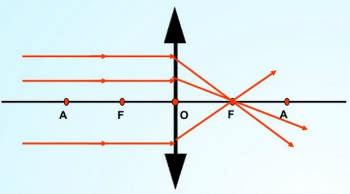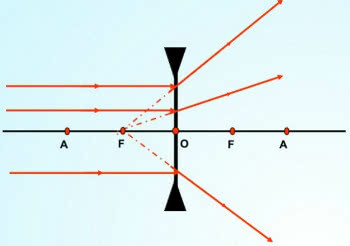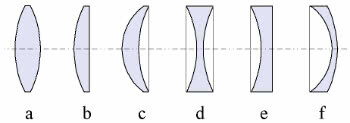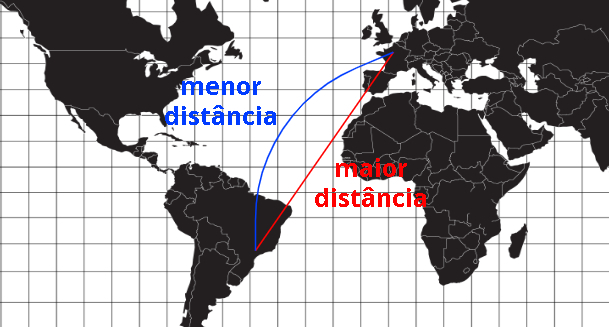Spherical lenses are part of the study of optical physics, being an optical device composed of three homogeneous and transparent media.
In this system, two diopters are associated, one of which is necessarily spherical. The other diopter can be flat or spherical.
Lenses are of great importance in our lives, since with them we can increase or reduce the size of an object.
Examples
Many everyday objects use spherical lenses, for example:
- Glasses
- Magnifying glass
- Microscopes
- telescopes
- Photo Cameras
- Camcorders
- Projectors
Types of Spherical Lenses
According to the curvature that feature, spherical lenses are classified into two types:
Converging lenses
Also called convex lenses, the converging lenses have an outward curvature. The center is thicker and the edge is thinner.

Convergent lens scheme
The main purpose of this type of ball lens is to increase objects. They get this name because the rays of light converge, that is, come closer.
Divergent Lenses
Also called concave lenses, the diverging lenses have an internal curvature. The center is thinner and the edge is thicker.

divergent lens scheme
The main purpose of this type of ball lens is to shrink the objects. They get this name because the light rays diverge, that is, move away.
Furthermore, according to the types of diopters which feature (spherical or spherical and flat), spherical lenses can be of six types:

Types of Spherical Lenses
Converging lenses
- a) Biconvex: has two convex faces
- b) Convex plane: one face is flat, the other is convex
- c) Concavo-convex: one face is concave and the other is convex
Divergent Lenses
- d) Biconcave: has two concave faces
- e) Concave Plan: one face is flat and the other is concave
- f) Convex-Concave: one face is convex and the other is concave
Note: Among these types, three of them have a thinner edge, and three have a thicker edge.
Want to know more about the topic? Read too:
- reflection of light
- light refraction
- flat mirrors
- spherical mirrors
- Light: Refraction, Reflection and Means of Propagation
- Physics Formulas
Image Formation
Imaging varies by lens type:
Convergent lens
Images can be formed in five cases:
- Real image, inverted and smaller than the object
- Real image, inverted and same object size
- Real image, inverted and larger than the object
- Improper image (is at infinity)
- Virtual image, to the right of the object and larger than it
divergent lens
As for the divergent lens, image formation is always: virtual, to the right of the object and smaller than it.
Focal Power
Each lens has a focal power, that is, the ability to converge or diverge light rays. Focal power is calculated by the formula:
P = 1/f
Being,
P: focal power
f: focal length (from lens to focus)
In the International System, the focal power is measured in Diopter (D) and the focal length in meters (m).
It is important to note that in converging lenses, the focal length is positive, which is why they are also called positive lenses. In divergent lenses, however, it is negative, and therefore, they are called negative lenses.
Examples
1. What is the focal power of a 0.10 meter focal length converging lens?
P = 1/f
P = 1/0.10
P = 10 D
2. What is the focal power of a 0.20 meter focal length divergent lens?
P = 1/f
P = 1/-0.20
P = - 5 D
Entrance Exam Exercises with Feedback
1. (CESGRANRIO) A real object is placed perpendicular to the main axis of a converging lens of focal length f. If the object is at a distance of 3f from the lens, the distance between the object and the image conjugated by that lens is:
a) f/2
b) 3f/2
c) 5f/2
d) 7f/2
e) 9f/2
Alternative b
2. (MACKENZIE) Considering a biconvex lens whose faces have the same radius of curvature, we can say that:
a) the radius of curvature of the faces is always equal to twice the focal length;
b) the radius of curvature is always equal to half of the reciprocal of its vergence;
c) it is always convergent, whatever the surrounding environment;
d) it is only convergent if the refractive index of the surrounding medium is greater than that of the lens material;
e) it is only convergent if the refractive index of the lens material is greater than that of the surroundings.
Alternative and
3. (UFSM-RS) An object is on the optical axis and at a distance P of a converging distance lens f. Being P bigger then f it's smaller than 2f, it can be said that the image will be:
a) virtual and larger than the object;
b) virtual and smaller than the object;
c) real and larger than the object;
d) real and smaller than the object;
e) real and equal to the object.
Alternative c

